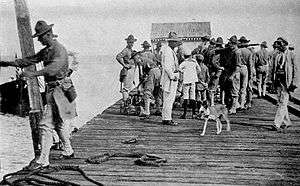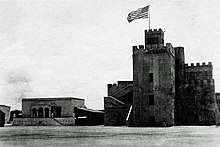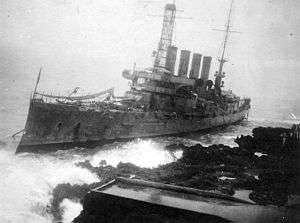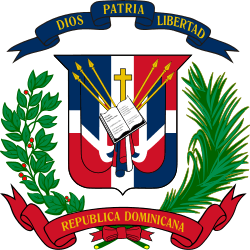United States occupation of the Dominican Republic (1916–1924)
The first United States occupation of the Dominican Republic lasted from 1916 to 1924. It was one of the many interventions in Latin America undertaken by the military forces of the United States in the 20th century. On the 13 May 1916,[3] Rear Admiral William B. Caperton forced the Dominican Republic's Secretary of War Desiderio Arias, who had seized power from Juan Isidro Jimenes Pereyra, to leave Santo Domingo by threatening the city with naval bombardment.[3]
| United States occupation of the Dominican Republic (1916–1924) | |||||||
|---|---|---|---|---|---|---|---|
| Part of the Banana Wars | |||||||
 U.S. Marines during the occupation | |||||||
| |||||||
| Belligerents | |||||||
|
|
| ||||||
| Commanders and leaders | |||||||
|
|
| ||||||
| Strength | |||||||
|
1,800 marines 1 armoured cruiser 2 protected cruisers 1 auxiliary cruiser 1 gunboat (1916) |
1,000 militia (1916) | ||||||
| Casualties and losses | |||||||
|
7 marines killed 15 marines wounded 40 sailors killed[1] 33 sailors missing 1 armoured cruiser sunk (1916) 144 marines killed 67+ wounded (1916–24)[2] |
100–300 casualties (1916) 950 killed or wounded (1916–24) | ||||||
Invasion
The piecemeal invasion resulted in the US Navy occupying all key positions in government and controlling the army and police. The first landing took place on the 5 May 1916, when "two companies of marines landed from the USS Prairie at Santo Domingo."[4] Their goal was to offer protection to the U.S. Legation and the U.S. Consulate, and to occupy the Fort San Geronimo. Within hours, these companies were reinforced with "seven additional companies."[4] On the 6 May American forces from the USS Castine landed to offer protection to the Haitian Legation, a country under similar military occupation from the U.S. Two days after the first landing, constitutional President, Juan Isidro Jimenes resigned.[5]
Admiral Caperton's forces occupied Santo Domingo on the 15 May 1916. Colonel Joseph H. Pendleton's Marine units took the key port cities of Puerto Plata and Monte Cristi on the 1 June and enforced a blockade.[6] The marines were able to occupy Monte Cristi without meeting any resistance. However, when the marines attacked Puerto Plata they were forced to fight their way into the city under heavy but inaccurate fire from about 500 pro-Arias irregulars. During this landing the Marines sustained several casualties, this included the death of Captain Herbert J. Hirshinger, who was the first marine killed in combat in the campaign.
After marching inland for roughly twenty-four hours a unit of marines encountered an entrenched Dominican force. The first major engagement occurred on the 27 June, at Las Trencheras, two ridges, which had been fortified by the Dominicans and long thought to be invulnerable, since a Spanish army had been defeated there in 1864. There the Dominican troops had dug trenches on two hills, one behind the other, blocking the road to Santiago. The field guns of Captain Chandler Campbell's 13th Company, along with a machine gun platoon, took position on a hill commanding the enemy trenches and opened fire at 08:00 hours. Under the cover of this fire, the marines launched a bayonet charge on the defenders' first line of defence, covered until the last possible moment by the artillery barrage. The Dominicans soldiers fled to their trenches on the second hill. They rallied there briefly, then broke and ran again as the American field guns resumed their shelling of the hill. Within 45 minutes from the opening artillery shots, the Marines, at a cost to themselves of one killed and four wounded, had overrun the enemy positions. They found no dead or weapons in the trenches but later discovered five rebel bodies in the nearby woods.[7]
This engagement set the pattern for most Marine contacts with hostile forces in the Dominican Republic. Against Marine superiority in artillery, machine guns, small-unit manoeuvre, and individual training and marksmanship, no Dominican force could hold its ground.[7]
Two days after the Battle of Guayacanas, on the 3 July the Marines moved onto Arias' stronghold in Santiago de los Caballeros.[8] However, "A military encounter was avoided when Arias arrived at an agreement with Capteron to cease resistance."[9] Three days after Arias left the country,[3] the rest of the occupation forces landed and took control of the country within two months,[3] and on the 29 November the United States imposed a military government under Captain (later Rear Admiral) Harry Shepard Knapp, Commander of the Cruiser Force aboard his flagship, USS Olympia (which still exists today in Philadelphia, Pennsylvania, USA).[3] [10]
The beginning of the occupation

Marines claimed to have restored order throughout most of the republic, with the exception of the eastern region, but resistance continued widespread in both, direct and indirect forms in every place.[11] The US occupation administration, however, measured its success through these standards: the country's budget was balanced, its debt was diminished, economic growth directed now toward the US; infrastructure projects produced new roads that allowed the movement of military personnel across all the country's regions for the first time in history;[12] a professional military organization that took away the power from local elites and made soldiers more loyal to the national government, the Dominican Constabulary Guard, replaced the former partisan forces responsible for the civil war with groups less hostile to the US occupation.[13]
Most Dominicans, however, greatly resented the loss of their sovereignty to foreigners, few of whom spoke Spanish or displayed much real concern for the welfare of the republic. A guerrilla movement, known as the gavilleros,[3] with leaders such as General Ramón Natera, enjoyed considerable support from the population in the eastern provinces of El Seibo and San Pedro de Macorís.[3] Having knowledge of the local terrain, they fought from 1917 to 1921 against the United States occupation.[14] The fighting in the countryside ended in a stalemate, and the guerrillas agreed to a conditional surrender.
Withdrawal

After World War I, public opinion in the United States began to run against the occupation.[3] Warren G. Harding, who succeeded Wilson in March 1921, had campaigned against the occupations of both Haiti and the Dominican Republic.[3] In June 1921, United States representatives presented a withdrawal proposal, known as the Harding Plan, which called for Dominican ratification of all acts of the military government, approval of a loan of $2.5 million USD for public works and other expenses, the acceptance of United States officers for the constabulary—now known as the National Guard (Guardia Nacional)—and the holding of elections under United States supervision. Popular reaction to the plan was overwhelmingly negative.[3] Moderate Dominican leaders, however, used the plan as the basis for further negotiations that resulted in an agreement between U.S. Secretary of State Charles Evans Hughes and Dominican Ambassador to the United States Francisco J. Peynado on June 30, 1922,[15] allowing for the selection of a provisional president to rule until elections could be organized.[3] Under the supervision of High Commissioner Sumner Welles, Juan Bautista Vicini Burgos assumed the provisional presidency on October 21, 1922.[3] In the presidential election of March 15, 1924, Horacio Vásquez Lajara, an American ally who cooperated with the United States government, handily defeated Peynado. Vásquez's Alliance Party (Partido Alianza) also won a comfortable majority in both houses of Congress.[3] With his inauguration on July 13, control of the republic returned to Dominican hands.[3]
Aftermath
Despite the withdrawal, there were still concerns regarding the collection and application of the country's custom revenues. To address this problem, representatives of the United States and the Dominican Republic governments met at a convention and signed a treaty, on December 27, 1924, which gave the United States control over the country's custom revenues.[16] In 1941, the treaty was officially repealed and control over the country's custom revenues was again returned to the government of the Dominican Republic.[16] However this treaty created lasting resentment of the United States among the people of the Dominican Republic.[17]
The Dominican Campaign Medal was an authorized U.S. service medal for those military members who had participated in the conflict.
See also
References
- Boot, Max (2014). The Savage Wars of Peace: Small Wars and the Rise of American Power. p. 169. ISBN 9780465064939.
- Ayres (2008). A Military Miscellany. ISBN 9780307488251.
- "USA Dominican Republic Resistance 1917-1921". The Dupuy Institute. December 16, 2000. Retrieved June 29, 2014.
- United States Naval Institute (1879). Proceedings of the United States Naval Institute. Annapolis, Md: U.S. Naval Institute. p. 239.
- Atkins, G. Pope & Larman Curtis Wilson. (1998). The Dominican Republic and the United States: From Imperialism to Transnationalism. Athens, Ga.: Univ. of Georgia Press. pp. 49. ISBN 978-0820319308.
- Musicant, Ivan (1990). The Banana Wars. New York: Macmillan Publishing Co. pp. 247–252. ISBN 978-0025882102.
- Fuller, Stephen M.; Cosmas, Graham A. (1974). "Marines in the Dominican Republic (1916-1924)" (PDF). US Marine Corps History and Museums Division. p. 16.

- Musicant. Banana Wars. pp. 253–263.
- Atkins and Wilson (1998). The Dominican Republic and the United States. p. 49.
- Domingo, United States Congress Senate Selected Committee on Haiti and Santo (1922). Inquiry Into Occupation and Administration of Haiti and Santo Domingo: Hearings Before a Select Committee on Haiti and Santo Domingo, United States Senate, Sixty-seventh Congress, First and Second Sessions, Pursuant to S. Res. 112 Authorizing a Special Committee to Inquire Into the Occupation and Administration of the Territories of the Republic of Haiti and the Dominican Republic ... U.S. Government Printing Office.
- Franks, Julie (June 1995). "The Gavilleros of the East: Social Banditry as Political Practice in the Dominican Sugar Region 1900-1924". Journal of Historical Sociology. 8 (2): 158–181. doi:10.1111/j.1467-6443.1995.tb00085.x.
- Emmer, P. C., Bridget Brereton, B. W. Higman (2004). "Education in the Caribbean," a chapter in General History of the Caribbean: The Caribbean in the Twentieth Century. Paris, London: UNESCO. p. 609. ISBN 978-0-333-724590.CS1 maint: multiple names: authors list (link)
- Haggerty, Richard A. (1989). "OCCUPATION BY THE UNITED STATES, 1916-24". Dominican Republic: A Country Study. Library of Congress. Retrieved June 29, 2014.
- McPherson, Alan (2013). Encyclopedia of U.S. Military Interventions in Latin America. Santa Barbara, CA: ABC-CLIO. pp. 223–2. ISBN 978-1598842609.
- Calder, Bruce J. (1984). The Impact of Intervention: The Dominican Republic during the U.S. Occupation of 1916–1924. Markus Wiener Publishers. p. 223. ISBN 978-1-55876-386-9. Retrieved September 22, 2011.
- JSTOR 2213777
- American foreign relations: a history. Since 1895, Volume 2, pg. 163
External links
- About.Com: The US Occupation of the Dominican Republic, 1916-1924
- globalsecurity.org:Dominican Republic Occupation (1916-24)
- Country Studies: Occupation by the United States, 1916-24
- The American War Library: Numbers of Americans Killed/Wounded, by Action
Links in Spanish
